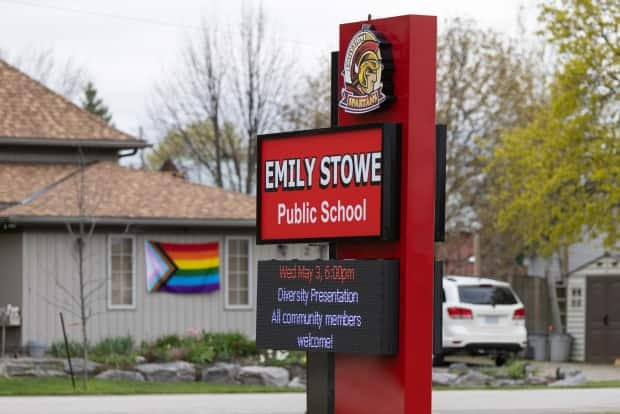After a controversial vote on pride flags in Ontario, LGBTQ+ students reflect on their meaning

Kaylee Johnson's high school in Saint John flies a pride flag on its grounds every year.
"When you walk into schools and places where you can see that representation, it just makes you feel very comfortable [and] welcome," Johnson, a member of the LGBTQ+ community, told CBC News.
As most Canadian provinces mark pride month in June, and others in August, the pride flag and versions of it have been at the centre of recent debates surrounding LGBTQ+ inclusion in schools. Students in the community say flying the flag is a gesture of support that makes them feel safe.
A recent decision by the York Catholic District School Board in Ontario not to fly the pride flag at an education centre in June was met with a divided reaction. Board members who voted not to raise the flag said they were committing to their religious teachings.
Anthea Peta-Dragos, a York Catholic senior student trustee who was present for the vote, said she was heartbroken for the school board's LGBTQ+ students.
"Flying the flag means inclusiveness, equity and feeling welcomed in schools," Peta-Dragos told CBC News.
"[LGBTQ+] students deserve our respect and our help, and that's what the flag would have encouraged if flown into the air."
LGBTQ+ students say pride flag curbs homophobia

Destiny Fenez and Jeorge McCallum, both 17-year-old high school students in St. Albert, Alta., are LGBTQ+ members of their school's gay-straight alliance.
Inside their school, teachers display progress pride flags and pride stickers in their classrooms — a small "calling card" to indicate that LGBTQ+ students are in a safe space, according to McCallum.
The flag can be a net-positive symbol in communities where enthusiastic support is harder to come by, they added.
"Not that it's always like outward hatred, but it's just like, 'those are other people and their problems are not my problems' ... So having the flag flown isn't just a symbol that we don't hate you, it's also, 'we will support you and we're going to help you where we can,'" McCallum explained.
Fenez agreed, adding that having pride flags displayed in classrooms helps curb homophobia inside the school.
"We don't need to worry about people in that class being rude or mean or homophobic as often because we can trust that teacher will actually take care of it," she said.
"While I haven't personally experienced it, I know that several other members of the community in school have experienced being called slurs before. And I've noticed that is a lot less likely to happen in classrooms where the pride flag" is on display.
WATCH | Pride flag stolen from Winnipeg school:
The students said they'd like to see more done inside schools to mark pride month, including class discussions and celebrations.
While an outward statement of allyship is welcome — like a pride flag on a pole outside the school grounds — educational programming geared towards pride will make the biggest difference to students, McCallum said.
Schools debate amid flag-related incidents
Ahead of the first day of pride month in several Canadian provinces on Thursday, debates around pride flags in schools have reemerged, as have acts of vandalism geared towards the flag.
One faith-based Canadian group called for a "national pride flag walkout day" on Thursday. Some religious parents in London, Ont., debated whether they would send their children to school.

Three Nova Scotia teens were charged last month for setting a pride flag on fire at Bay View High School in Upper Tantallon, N.S., an act that the RCMP said was motivated by hate.
Meanwhile, a Niagara Catholic school trustee was shown in a video drawing a comparison between flying the pride flag and the Nazi flag, CBC News reported this week.
Paolo de Buono, a Catholic teacher and trustee at a different school board in Ontario who criticized the outcome of the YCDSB vote, said he's been advocating since 2020 for Catholic school boards to fly the pride flag.
"Inclusion is really important, making people feel that they belong, they are respected, they are loved. It's easy to say but it's harder to show," said de Buono.
"I know that the flag doesn't show everything, but it's a small gesture towards the greater steps that we accept and love our students who are 2SLGBTQI+," he said, including abbreviations for two-spirit and intersex people.
Back in New Brunswick, Johnson — who recently co-organized a walk-out to protest the provincial government's decision to review a policy affirming LGBTQ+ rights — emphasized the role that teachers can play in schools where the pride flag isn't displayed.
"If the school's not going to do stuff like putting up the flag ... I think teachers are a big aspect of it, just making sure that they're ensuring their students that it is a safe place and they can be who they are in their school," she said.


